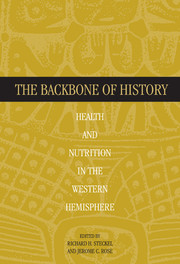Book contents
- Frontmatter
- Contents
- Preface
- List of Contributors
- PART I
- PART II METHODOLOGY
- PART III EURO-AMERICANS AND AFRICAN-AMERICANS IN NORTH AMERICA
- Introduction
- 5 The Health of the Middle Class: The St. Thomas' Anglican Church Cemetery Project
- 6 The Poor in the Mid-Nineteenth-Century Northeastern United States: Evidence from the Monroe County Almshouse, Rochester, New York
- 7 The Effects of Nineteenth-Century Military Service on Health
- 8 The Health of Slaves and Free Blacks in the East
- 9 The Quality of African-American Life in the Old Southwest near the Turn of the Twentieth Century
- PART IV NATIVE AMERICANS IN CENTRAL AMERICA
- PART V NATIVE AMERICANS AND EURO-AMERICANS IN SOUTH AMERICA
- PART VI NATIVE AMERICANS IN NORTH AMERICA
- PART VII
- PART VIII
- PART IX EPILOGUE
- Index
6 - The Poor in the Mid-Nineteenth-Century Northeastern United States: Evidence from the Monroe County Almshouse, Rochester, New York
Published online by Cambridge University Press: 01 March 2010
- Frontmatter
- Contents
- Preface
- List of Contributors
- PART I
- PART II METHODOLOGY
- PART III EURO-AMERICANS AND AFRICAN-AMERICANS IN NORTH AMERICA
- Introduction
- 5 The Health of the Middle Class: The St. Thomas' Anglican Church Cemetery Project
- 6 The Poor in the Mid-Nineteenth-Century Northeastern United States: Evidence from the Monroe County Almshouse, Rochester, New York
- 7 The Effects of Nineteenth-Century Military Service on Health
- 8 The Health of Slaves and Free Blacks in the East
- 9 The Quality of African-American Life in the Old Southwest near the Turn of the Twentieth Century
- PART IV NATIVE AMERICANS IN CENTRAL AMERICA
- PART V NATIVE AMERICANS AND EURO-AMERICANS IN SOUTH AMERICA
- PART VI NATIVE AMERICANS IN NORTH AMERICA
- PART VII
- PART VIII
- PART IX EPILOGUE
- Index
Summary
ABSTRACT
Data were collected from254 skeletons at the Monroe County Almshouse in Rochester, NewYork, dating from1826–1863.Additional evidence was used to calculate mortality rates for paupers (Brighton Town Clerk's Records) and the general population of the City of Rochester (Mount Hope records and census data). Because death rates were so high at the almshouse, the signs of biological stress observed in the skeletons, with the possible exception of infants, were probably not the result of institutionalization but, rather, the result of nutritional inadequacies or diseases experienced outside the almshouse. Documentary evidence indicates that mortality in the City of Rochester around the middle of the nineteenth century was highly variable and characterized by considerable infectious and parasitic diseases. Infant and early childhood mortality was severe. At the Monroe County Almshouse almost one-half of the subadults (as evidenced in both the skeletal collection and the BTC Record) died within the first year of life.
The health index for the sample is 72.3% of the possible maximum score, which is higher than that for the St. Thomas' Anglican Church sample. Documentary evidence, when available, should be included in the overall assessment of health among skeletal samples. It is evident from the Brighton Town Clerk's record that acute infectious disease played a major role in the mortality experience of almshouse residents, a situation that was not incorporated into the Mark I version of the index. In some respects, inmates of the almshouse do not appear much different from the population in general, for example, with respect to the stature of adult males.
- Type
- Chapter
- Information
- The Backbone of HistoryHealth and Nutrition in the Western Hemisphere, pp. 162 - 184Publisher: Cambridge University PressPrint publication year: 2002
- 9
- Cited by



